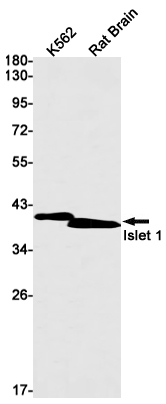-
Product Name
Anti-Islet 1 Rabbit antibody
- Documents
-
Description
Islet 1 Rabbit monoclonal antibody
-
Tested applications
WB, IHC-P, ICC/IF, FC, IP
-
Species reactivity
Human
-
Alternative names
Isl-1; ISLET1 antibody
-
Isotype
Rabbit IgG
-
Preparation
Antigen: Recombinant protein of human Islet 1
-
Clonality
Monoclonal
-
Formulation
Supplied in 50nM Tris-Glycine(pH 7.4), 0.15M Nacl, 40%Glycerol, 0.01% sodium azide and 0.05% BSA.
-
Storage instructions
Store at 4°C short term. Aliquot and store at -20°C long term. Avoid freeze / thaw cycle.
-
Applications
1:1000-1:5000
1:50-1:200
1:50-1:200
1:20
1:20-1:50
-
Validations

Western blot detection of Islet 1 in K562,Rat Brain lysates using Islet 1 Rabbit mAb(1:1000 diluted).Predicted band size:39kDa.Observed band size:39kDa.
-
Background
Swiss-Prot Acc.P61371.DNA-binding transcriptional activator. Recognizes and binds to the consensus octamer binding site 5'-ATAATTAA-3' in promoter of target genes. Plays a fundamental role in the gene regulatory network essential for retinal ganglion cell (RGC) differentiation. Cooperates with the transcription factor POU4F2 to achieve maximal levels of expression of RGC target genes and RGC fate specification in the developing retina. Involved in the specification of motor neurons in cooperation with LHX3 and LDB1. Binds to insulin gene enhancer sequences. Essential for heart development. Marker of one progenitor cell population that give rise to the outflow tract, right ventricle, a subset of left ventricular cells, and a large number of atrial cells as well, its function is required for these progenitors to contribute to the heart. Controls the expression of FGF and BMP growth factors in this cell population and is required for proliferation and survival of cells within pharyngeal foregut endoderm and adjacent splanchnic mesoderm as well as for migration of cardiac progenitors into the heart .
Related Products / Services
Please note: All products are "FOR RESEARCH USE ONLY AND ARE NOT INTENDED FOR DIAGNOSTIC OR THERAPEUTIC USE"
